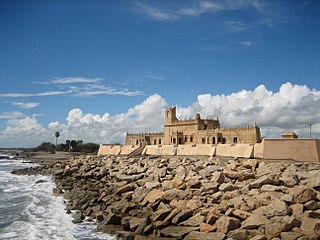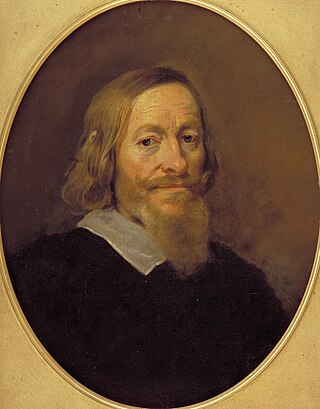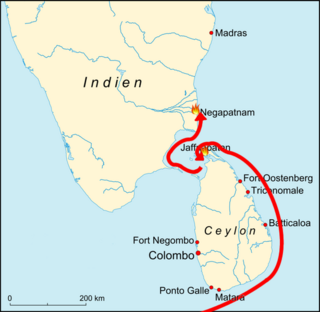
Tharangambadi, formerly Tranquebar, is a town in the Mayiladuthurai district of the Indian state of Tamil Nadu on the Coromandel Coast. It lies 15 kilometres (9.3 mi) north of Karaikal, near the mouth of a distributary named Uppanar of the Kaveri River. Tranquebar was established on 19 November 1620 as the first Danish trading post in India. King Christian IV had sent his envoy Ove Gjedde who established contact with Raghunatha Nayak of Tanjore. An annual tribute was paid by the Danes to the Rajah of Tanjore until the colony of Tranquebar was sold to the British East India Company in 1845.
The Danish West India Company or Danish West India–Guinea Company was a Dano-Norwegian chartered company that operated out of the colonies in the Danish West Indies. It is estimated that 120,000 enslaved Africans were transported on the company's ships. Founded as the Danish Africa Company in 1659, it was incorporated into the Danish West India Company in 1671.

Danish India was the name given to the colonies of Denmark in the Indian subcontinent, forming part of the Danish overseas colonies. Denmark–Norway held colonial possessions in India for more than 200 years, including the town of Tharangambadi in present-day Tamil Nadu state, Serampore in present-day West Bengal, and the Nicobar Islands, currently part of India's union territory of the Andaman and Nicobar Islands. The Danish and Norwegian presence in India was of little significance to the major European powers as they presented neither a military nor a mercantile threat. Dano-Norwegian ventures in India, as elsewhere, were typically undercapitalized and never able to dominate or monopolize trade routes in the same way that British, French, and Portuguese ventures could.

Ove Gjedde was a Danish nobleman and Admiral of the Realm. He established the Danish colony at Tranquebar and constructed Fort Dansborg as the base for the Danish settlement. He was a member of the interim government that followed the death of King Christian IV, which imposed restrictions by the Haandfæstningon his successor King Frederick III.

Danish Asiatic Company was a Danish trading company established in 1730 to revive Danish trade on the Danish East Indies and China following the closure of the Danish East India Company. It was granted a 40-year monopoly on Danish trade on Asia in 1732 and taken over by the Danish government in 1772. It was headquartered at Asiatisk Plads in Copenhagen. Its former premises are now used by the Ministry of Foreign Affairs.

HDMS Det Store Bælt was a frigate of the Royal Dano-Norwegian Navy, launched in 1782. In 1800, she was sold to the Danish Asiatic Company and renamed Holsteen.
Dokken was an East Indiaman of the Danish Asiatic Company, built at Andreas Bodenhoff's Dockyard in 1742. She vanished on the way back from her fourth expedition to Tranquebar in Danish India, in 1751, between the Cape of Good Hope and Europe.

The Dano-Mughal War, formally Danish East India Company's War against the Mughal Empire, was a colonial and maritime conflict between the Mughal Empire and the Danish East India Company over trade commerce in the Bay of Bengal. Lasting from 1642 to 1698, the conflict has also been referred to by historians as the Dano-Bengali Thirty Years' War

The Cattle War also commonly referred to as the Perumal War or the Perumal Naik-War was a colonial conflict between the Danish East India Company and the Thanjavur Maratha kingdom over the Danish governor Hans Georg Krog's expansionistic foreign policy. The conflict started over the raiding of Danish cattle by the local supervisor of a small land district, Perumal Naik.

The Action of 19 February 1619 was a naval engagement between Denmark-Norway, under the leadership of Ove gjedde, and French privateers, which took place on 19 February 1619, during the first Danish expedition to India. Two French vessels were taken and incorporated into the Royal Danish Navy.

The Loss of the St. Jacob also referred to as the Seizure of St. Jacob was a destruction and seizure of the Danish merchant ship, St. Jacob, by local Bengali authorities. The loss and destruction of the ship and its crew, led to the Dano-Mughal War, which would last for 56 years.

The Siege of Dansborg or the Siege of Fort Dansborg, was a short siege lasting from 20 to 30 December 1644, between general Tiagepule of Thanjavur and the Danish command at Fort Dansborg. The conflict started over the Danish rejection of the general's demand to tax Tranquebar, and as a result, a series of confrontations followed. The confrontations had no major result, and an armistice may have been signed.

The Siege of Dansborg or the Siege of Fort Dansborg, was a siege of the newly finished Danish fort of Dansborg in Trangebar in 1624. The siege was initiated by the nayak of Thanjavur, Raghunatha, because of the Danish rejection of the demands from the nayak. The Siege, laid by general Calicut, was abandoned after the arrival of Danish reinforcements from sea. The event is mostly described by Icelander, Jón Ólafsson, in his work The Life of the Icelander Jón Ólafsson, Traveller to India.

Roland Crappé's raids on Portuguese colonies refers to a series of raids by Dutchman in Danish service, Roland Crappé, on Portuguese Ceylon and India. The raids were partially unsuccessful, in that Crappé's ship, Øresund, caught fire and sank.

The Ambush near the Bay of Manila, alternatively the Death of Bernt Pessart, was an ambush by the Indigenous peoples of the Philippines, against a combined Dano-Dutch espionaging expeditionary force in 1645. The ambush led to the death of former governor and president of Danish India, Bernt Pessart.

The Sieges of Tranquebar or the War between Tranquebar and Thanjavur refers to the warfare between the Thanjavur Nayak kingdom and Danish Tranquebar between 1655 – 1669. The Thanjavurian sieges were repelled, mainly due to the new fortifications being built around Tranquebar, and a peace agreement was issued in 1669.

The Conflict between William Leyel and Bernt Pessart refers to the tensions and minor civil war between Willem Leyel and Bernt Pessart over the governorship of Tranquebar and the Danish East India Company. The conflict led to the escape of Bernt Pessart, and the command at Tranquebar accepted Willem Leyel as governor of Danish India.
Roland Crappé or Roelant Crappé was a Dutch colonial official serving the Dutch and Danish East India Company. He became director general of the Ceylonese department of the Danish East India Company in 1618 and became commander in chief and governor of Tranquebar upon his seventh arrival in the Indies in 1624. During his leadership, new factories and offices were established and Danish trade went exceptionally well. He died in 1644 only a few years after his homecoming to Denmark.
The Tranquebar Treaty of 1620 formally the Treaty between Raghunatha Nayak and Christian IV, was a treaty of friendship between the Thanjavur Nayak kingdom and Denmark–Norway in 1620. The treaty would establish Danish Tranquebar: a base that would be the headquarters of Danish India for the next 200 years.


















